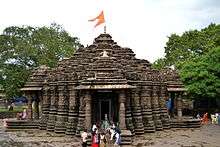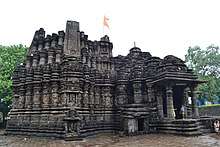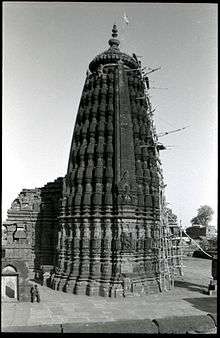Shiv Mandir, Ambarnath



The Shiv Mandir of Ambarnath is a historic 11th-century Hindu temple, still in use, at Ambarnath near Mumbai, in Maharashtra, India. It is also known as the Ambreshwar Shiva Temple, and known locally as Puratana Shivalaya. It is situated on the bank of Vadavan (Waldhuni) river, 2 km away from Ambarnath (East) railway station. The temple was built in 1060 AD[1] in the Hemadpanti style, beautifully carved in stone. It was probably built by Shilahara king Chhittaraja, it may also have been rebuilt by his son Mummuni.[2]
Unusually, the sanctuary or garbhagriha is below ground, reached by some 20 steps down from the mandapa, and is open to the sky as the shikhara tower above stops abruptly at a little above the height of the mandapa, and was apparently never completed. It is in bhumija form, and if completed would have been close in form to the Udayesvara Temple in Udaipur, Madhya Pradesh, begun in 1059,[3] and the Gondeshwar Temple at Sinnar.[4] It is clear from what was built that the shikhara would have followed these in having four corner bands of gavaksha-honeycomb sweeping uninterrupted up the full height of the tower, while in between each face has rows of five spirelets on individual podia, reducing in size up the tower.[5]
The mandapa has three porches. Much of the exterior figure carving is damaged, but some female and divine figures remain.[6]
People all over World have faith in of Lord Shiv and so often visit here .
Shiv Mandir art festival is a festival to promote tourism here
Legends
A legend states that the temple was built by the five Pandava brothers in just one night in a huge single mass of stone. It is said that Pandava brothers of the epic Mahabharta fame for taking a night refuge during their period of exile (vanvaas). They could not complete the structure, which even today is missing the roof directly above the main sanctum area (garbhagriha) of the temple. It is also said that there is a kilometre long underground tunnel to the temple which is now closed.
Visiting.
This temple is overcrowded in Mahashivaratri . On the day of Mahashivaratri, Ambarnath's Eastern side is blocked for vehicles and route is diverted for vehicles due to heavy traffic of pilgrims. The Temple becomes overcrowded again in the month of Shraavana to get blessings from Lord Shiva.
Pooja, like Rudra Abhishek can be performed on the temple premises.
References
External links
| Wikimedia Commons has media related to Shiva temple of Ambarnath. |